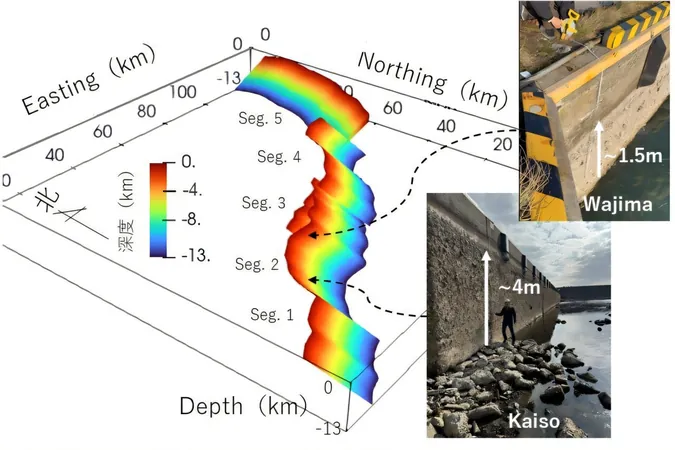
Unveiling the Secrets of the Noto Quake: A 3D Model Revolutionizes Earthquake Understanding
2025-04-29
Author: Arjun
Devastation Strikes the Noto Peninsula
On January 1, 2024, a staggering 7.5-magnitude earthquake rocked the Noto Peninsula in Japan, unleashing widespread destruction across the region. The quake's impact was magnified by severe uplift, where the very land itself surged upward due to the relentless shifting of tectonic plates. Some areas experienced a jaw-dropping rise of up to 5 meters, leaving a lasting mark on the landscape.
A Groundbreaking 3D Model
In an effort to decode the intricacies of earthquake dynamics, Japanese researchers have developed a cutting-edge 3D model of the fault lines influenced by this seismic event. By harnessing advanced simulations, they aim to reveal how the unique characteristics of these faults contribute to the earthquake's effects, potentially paving the way for improved disaster mitigation strategies.
Insight from the Experts
Ryosuke Ando, an associate professor at the University of Tokyo and lead author of the study, emphasized the crucial goal behind this research: "During the Noto Peninsula earthquake, we witnessed distressing variations in uplift across different areas. Our study aims to unravel the mechanisms that control both the magnitude and the patterns of fault slip and resultant ground surface uplift."
Learning from the Past
The team sought to create a model reflecting the Noto quake's characteristics, leveraging data collected prior to the disaster—such as detailed information about the fault lines and seismic activity leading up to the event. By aligning simulations with the actual fault characteristics, they could recreate the earthquake's dynamics.
Three Faults, One Epic Event
The 2024 quake involved three primary faults, known as conjugate faults, which display opposing lateral movements. Two of these—the Monzen Fault and the Noto Peninsula Hoku-gan Fault Zones—dip southeast, while the third, the Toyama Trough Sei-en Fault, dips northwest. The team's analysis focused on how this unique fault geometry influences seismic behavior.
Harnessing High-Tech Simulations
Utilizing observational data about fault traces and their dip angles, the researchers crafted an intricate 3D model of the fault's geometry. Historical seismic activity, characterized by years of localized swarms of smaller quakes, helped set the stage for the model's stress conditions.
Unraveling the Uplift Mystery
The simulations revealed crucial insights, effectively replicating the varied uplift seen during the Noto earthquake. In regions where uplift was pronounced, the damage was catastrophic, while adjacent areas with minimal uplift escaped serious harm. This underscores the significance of fault geometry in determining the earthquake's land impacts.
Looking Towards the Future
Ando noted the pivotal role of their supercomputer-generated analysis: "We illustrated that the irregular fault geometry was instrumental in dictating the earthquake's overall behavior, aligning it with the compressive forces acting on the tectonic plates in this region.” Moving forward, the researchers are eager to leverage this model to shape more effective dynamic rupture scenarios, preparing us for future seismic challenges.





 Brasil (PT)
Brasil (PT)
 Canada (EN)
Canada (EN)
 Chile (ES)
Chile (ES)
 Česko (CS)
Česko (CS)
 대한민국 (KO)
대한민국 (KO)
 España (ES)
España (ES)
 France (FR)
France (FR)
 Hong Kong (EN)
Hong Kong (EN)
 Italia (IT)
Italia (IT)
 日本 (JA)
日本 (JA)
 Magyarország (HU)
Magyarország (HU)
 Norge (NO)
Norge (NO)
 Polska (PL)
Polska (PL)
 Schweiz (DE)
Schweiz (DE)
 Singapore (EN)
Singapore (EN)
 Sverige (SV)
Sverige (SV)
 Suomi (FI)
Suomi (FI)
 Türkiye (TR)
Türkiye (TR)
 الإمارات العربية المتحدة (AR)
الإمارات العربية المتحدة (AR)